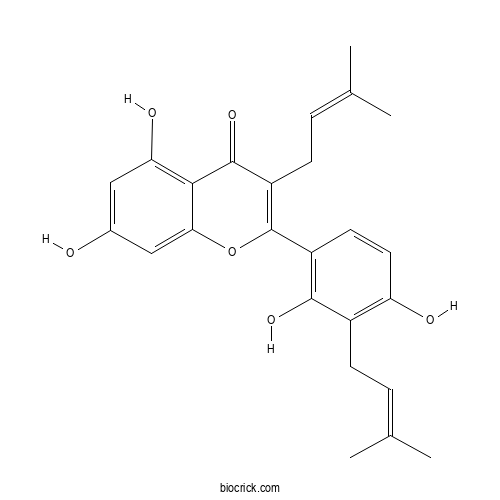Kuwanon TCAS# 100187-66-4 |

Quality Control & MSDS
3D structure
Package In Stock
Number of papers citing our products

| Cas No. | 100187-66-4 | SDF | Download SDF |
| PubChem ID | 15231527.0 | Appearance | Powder |
| Formula | C25H26O6 | M.Wt | 422.47 |
| Type of Compound | N/A | Storage | Desiccate at -20°C |
| Solubility | Soluble in Chloroform,Dichloromethane,Ethyl Acetate,DMSO,Acetone,etc. | ||
| Chemical Name | 2-[2,4-dihydroxy-3-(3-methylbut-2-enyl)phenyl]-5,7-dihydroxy-3-(3-methylbut-2-enyl)chromen-4-one | ||
| SMILES | CC(=CCC1=C(C=CC(=C1O)C2=C(C(=O)C3=C(C=C(C=C3O2)O)O)CC=C(C)C)O)C | ||
| Standard InChIKey | KATQHJZHAFCFAQ-UHFFFAOYSA-N | ||
| Standard InChI | InChI=1S/C25H26O6/c1-13(2)5-7-16-19(27)10-9-17(23(16)29)25-18(8-6-14(3)4)24(30)22-20(28)11-15(26)12-21(22)31-25/h5-6,9-12,26-29H,7-8H2,1-4H3 | ||
| General tips | For obtaining a higher solubility , please warm the tube at 37 ℃ and shake it in the ultrasonic bath for a while.Stock solution can be stored below -20℃ for several months. We recommend that you prepare and use the solution on the same day. However, if the test schedule requires, the stock solutions can be prepared in advance, and the stock solution must be sealed and stored below -20℃. In general, the stock solution can be kept for several months. Before use, we recommend that you leave the vial at room temperature for at least an hour before opening it. |
||
| About Packaging | 1. The packaging of the product may be reversed during transportation, cause the high purity compounds to adhere to the neck or cap of the vial.Take the vail out of its packaging and shake gently until the compounds fall to the bottom of the vial. 2. For liquid products, please centrifuge at 500xg to gather the liquid to the bottom of the vial. 3. Try to avoid loss or contamination during the experiment. |
||
| Shipping Condition | Packaging according to customer requirements(5mg, 10mg, 20mg and more). Ship via FedEx, DHL, UPS, EMS or other couriers with RT, or blue ice upon request. | ||

Kuwanon T Dilution Calculator

Kuwanon T Molarity Calculator
| 1 mg | 5 mg | 10 mg | 20 mg | 25 mg | |
| 1 mM | 2.367 mL | 11.8352 mL | 23.6703 mL | 47.3406 mL | 59.1758 mL |
| 5 mM | 0.4734 mL | 2.367 mL | 4.7341 mL | 9.4681 mL | 11.8352 mL |
| 10 mM | 0.2367 mL | 1.1835 mL | 2.367 mL | 4.7341 mL | 5.9176 mL |
| 50 mM | 0.0473 mL | 0.2367 mL | 0.4734 mL | 0.9468 mL | 1.1835 mL |
| 100 mM | 0.0237 mL | 0.1184 mL | 0.2367 mL | 0.4734 mL | 0.5918 mL |
| * Note: If you are in the process of experiment, it's necessary to make the dilution ratios of the samples. The dilution data above is only for reference. Normally, it's can get a better solubility within lower of Concentrations. | |||||

Calcutta University

University of Minnesota

University of Maryland School of Medicine

University of Illinois at Chicago

The Ohio State University

University of Zurich

Harvard University

Colorado State University

Auburn University

Yale University

Worcester Polytechnic Institute

Washington State University

Stanford University

University of Leipzig

Universidade da Beira Interior

The Institute of Cancer Research

Heidelberg University

University of Amsterdam

University of Auckland

TsingHua University

The University of Michigan

Miami University

DRURY University

Jilin University

Fudan University

Wuhan University

Sun Yat-sen University

Universite de Paris

Deemed University

Auckland University

The University of Tokyo

Korea University
- Epimedin I
Catalog No.:BCX0752
CAS No.:205445-00-7
- Cyaonoside A
Catalog No.:BCX0751
CAS No.:110081-91-9
- Epipinoresinol-4-O-glucopyranoside
Catalog No.:BCX0750
CAS No.:24404-49-7
- Emetine
Catalog No.:BCX0749
CAS No.:483-18-1
- Yuanhuadine
Catalog No.:BCX0748
CAS No.:76402-66-9
- Kuwanon B
Catalog No.:BCX0747
CAS No.:62949-78-4
- guan-fu base H
Catalog No.:BCX0746
CAS No.:4758-99-0
- Saikosaponin K
Catalog No.:BCX0745
CAS No.:405229-61-0
- Astragenol
Catalog No.:BCX0744
CAS No.:86541-79-9
- Yuanhuacine
Catalog No.:BCX0743
CAS No.:60195-70-2
- Taxifolin 7-O-β-D-glucoside
Catalog No.:BCX0742
CAS No.:14292-40-1
- Edgeworoside C
Catalog No.:BCX0741
CAS No.:126221-40-7
- luteolin-7-O-gentiobiside
Catalog No.:BCX0754
CAS No.:70855-41-3
- Dihydroferulic acid
Catalog No.:BCX0755
CAS No.:1135-23-5
- Ergothioneine
Catalog No.:BCX0756
CAS No.:497-30-3
- Anemarrhenasaponin A2
Catalog No.:BCX0757
CAS No.:117210-12-5
- Mogroside VI A
Catalog No.:BCX0758
CAS No.:2146088-13-1
- Pulchinenoside E4
Catalog No.:BCX0759
CAS No.:1415553-83-1
- Mogroside VI B
Catalog No.:BCX0760
CAS No.:2149606-17-5
- Oleuropeinic acid
Catalog No.:BCX0761
CAS No.:96382-90-0
- Prosapogenin D
Catalog No.:BCX0762
CAS No.:103629-72-7
- 3,4'-Dihydroxyflavone
Catalog No.:BCX0763
CAS No.:14919-49-4
- Cis-Ligupurpuroside B
Catalog No.:BCX0764
CAS No.:350588-96-4
- 6-Methylflavone
Catalog No.:BCX0765
CAS No.:29976-75-8
Kuwanon T and Sanggenon a Isolated from Morus alba Exert Anti-Inflammatory Effects by Regulating NF-kappaB and HO-1/Nrf2 Signaling Pathways in BV2 and RAW264.7 Cells.[Pubmed:34946724]
Molecules. 2021 Dec 16;26(24):7642.
We previously investigated the methanolic extract of Morus alba bark and characterized 11 compounds from the extract: kuwanon G (1), kuwanon E (2), Kuwanon T (3), sanggenon A (4), sanggenon M (5), sanggenol A (6), mulberofuran B (7), mulberofuran G (8), moracin M (9), moracin O (10), and norartocarpanone (11). Herein, we investigated the anti-inflammatory effects of these compounds on microglial cells (BV2) and macrophages (RAW264.7). Among them, 3 and 4 markedly inhibited the lipopolysaccharide (LPS)-induced production of nitric oxide in these cells, suggesting the anti-inflammatory properties of these two compounds. These compounds inhibited the production of prostaglandin E2, interleukin-6, and tumor necrosis factor-alpha, and the expression of inducible nitric oxide synthase and cyclooxygenase-2 following LPS stimulation. Pretreatment with 3 and 4 inhibited the activation of the nuclear factor kappa B signaling pathway in both cell types. The compounds also induced the expression of heme oxygenase (HO)-1 through the activation of nuclear factor erythroid 2-related factor 2. Suppressing the activity of HO-1 reversed the anti-inflammatory effects caused by pretreatment with 3 and 4, suggesting that the anti-inflammatory effects were regulated by HO-1. Taken together, 3 and 4 are potential candidates for developing therapeutic and preventive agents for inflammatory diseases.


